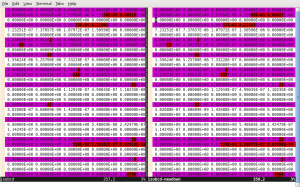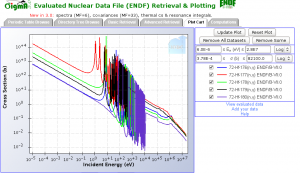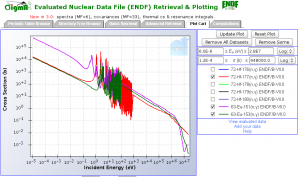OK! MC**2 is up and running on my VM. In comparing the results with those from new-down, I discovered that getting the side-by-side diff mode in VIM is really easy, and I don’t need that cream program anymore. Just use
vim -d file1.txt file2.txt
Then, use Ctrl+w to control the windows:
- C+w C+w switches windows
- C+w = makes the windows equal size
- C+w < or > change the window sizes
Awesome. Here’s a screenshot of this great tool:

As you can sort of see, the results from my VM and the results from new-down match very well. Enough for me to use lappy laptop for lattice physics of fast reactors. It’s about 10 times faster than new-down, which is a 10 year old SPARC Solaris machine with a 450 MHz processor and 512MB of RAM. Processor info on this sun machine found by executing:
/usr/platform/sun4u/sbin/prtdiag
It’s snowing hard right now. There are about 3 new inches piling up. I had to wear ski goggles to work today.
As for the Europium case, I’ll need to deal with the fission product MC2 template. It has Eu151 through Eu157 as FPs, which I know from experience with Hf will cause problems when I try to add in more Eu at the top of the input. The question is two-fold: 1. How much of the Eu chain would we like to model explicitly? and 2. Should we disregard Eu as a fission product if we use it as a BP? The answer to the second might be easiest. If we are loading in Eu, the amount we load will be significantly higher than the amoun that would build up from fission, so yes, it is a good approximation to ignore fission production. As for the first question, Eu-151 and 153 are naturally occurring and the others all have short half lives on the order of 5-10 years. I’ll start by modelling up to 154, with absorptions above that going to the lumped fission products. All beta decays will also go to lumped fission products that Gadolinium is a member of (LFP41). With that in mind, I’ll eliminate all Eu except 155 through 157 from the fission product list in mc2FP.template.
The sfrCalc script is running nicely on the new VM MC**2 server. I’ve modified the templates to work with the Eurpium. Still working kinks out of sfrCalc script. Spent some time with 442 students and with Maru doing Origen stuff for Ewing’s class. The rebus run failed initially because the MC2 files had ZR I and FE I instead of ZIRCI and IRONI. I changed the table in the imd file for fuel-loading-eu in the templates folder to give the proper labels (t0 maintain compatibility with other templates I’ve used). After regenerating the cross sections, rebus runs.
Oddity: My nexenta distro has the wrong time.

